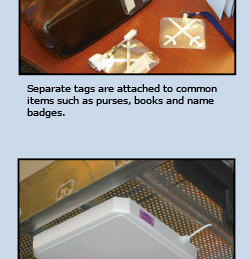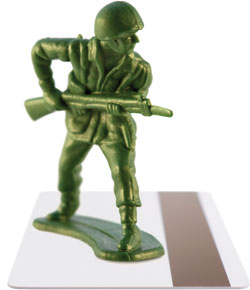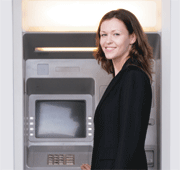ID applications that scare the public
14 July, 2008
category: Biometrics, Library, RFID
The identification industry had a wakeup call in 2005 when parents protested the use of RFID tags in student ID badges at Brittan Elementary School in Sutter, Calif.
RFID tags were used to take attendance at the school when the children walked in the door. The plan was to eventually place scanners around the school to monitor student movement throughout the day. But it didn’t get that far.
Parents rallied against the system, and legislation is still pending in the California legislature to impose restrictions on ID technologies that communicate via radio frequency waves.
Since then, many would say RFID use in public education would not be seen in our near future. But two projects are testing how RFID can work in educational institutions. One is an experiment at the University of Washington in Seattle, which is using RFID to tag equipment, faculty, staff and students.
Another one is being kept quiet. A north suburban Chicago public high school has started using RFID to monitor students. The 3,500 student ID badges have Gen 2 RFID chips embedded from Premier Electronics, Crystal Lake, Ill. The RFID tags cost $2.95 each.
The high school, which asked not to be identified, enables juniors and seniors to go off campus for lunch. The RFID system is used to make sure the students leaving the campus are eligible to leave the school.
The students can only use two exits to leave the school during lunch. Previously a security guard would be at each of the entrances and check the badges to make sure the students could leave. If a student has disciplinary issues, his open campus privileges can be revoked. The school also wanted to make sure that only upper classmen leave. In the past, the security guards would scan a bar code on the back of the student badges.
The problem with this system is that it took 15 to 20 minutes for the students to get out the door and it left them with little time for lunch.
 The RFID has automated the line to a certain extent. As the students approach the door their RFID tag embedded in the student ID badge is read. The tag transmits a serial number that is linked to the student. A security guard is still at the door, but after the tag is read the student’s picture is brought up on a computer monitor along with a red or green bar that says whether or not the student is eligible to leave. The new system has made it a lot quicker for students to get out the door for lunch.
The RFID has automated the line to a certain extent. As the students approach the door their RFID tag embedded in the student ID badge is read. The tag transmits a serial number that is linked to the student. A security guard is still at the door, but after the tag is read the student’s picture is brought up on a computer monitor along with a red or green bar that says whether or not the student is eligible to leave. The new system has made it a lot quicker for students to get out the door for lunch.
The system was deployed shortly after the school year started in the fall of 2007. Initially, there was some concern among the students about Big Brother and being tracked, but once they saw how well it worked and how easy it was to get off campus, they began to accept it, says a school administrator who asked not to be identified. The parents also have accepted the technology with very little resistance.
Although there has been good reception to the system, the school knows it could be dealing with some controversy once word gets out. That’s why they’re asking not be named yet. Once they have some additional success with the system they will go public, the administrator says.
For this school year, the system is just being used to make sure students can get off campus for lunch, but the school is looking at additional applications. Administrators want to put RFID sensors in a student lounge area to make sure students aren’t cutting class. The school is also going to buy handheld sensors to do spot checks at after-school events. For example, if a student has disciplinary issues, he might not be allowed on campus for basketball games or other activities.
Premier Electronics is seeing how the system works and wants to try and sell it to other schools, says John Cook, sales manager with Premier Electronics. The system can also use facial recognition biometrics to confirm the cardholder’s identity with a picture stored in a database. This feature isn’t functioning at the school because legislation restricting the use of biometrics in public schools in Illinois.
The University of Washington is experimenting with RFID to see how it works, developing some human-centric applications for the technology, as well as exploring the privacy concerns around the technology, says Magdalena Balazinska, assistant professor at the university.
The university is using the same tags as the Illinois high school and has 35 RFID readers and 150 antennas throughout the six-story Paul Allen Center for Computer Science and Engineering. Balazinska has 12 people participating in the experiment but hopes to grow that to 50 volunteers. The National Science Foundation, Microsoft Research and the UW’s College of Engineering are funding the project.
In the initial implementation phase, they have enabled users to view his or her movements through the course of the day. Volunteers can also tag personal belongings. Users can then go onto a Web site to find out where they were throughout the day. Also, if they can’t find something, such as a laptop, they can search for that as well.
The system, which was activated in March, initially has proven to be less than reliable, Balazinska says. Water has been known to interfere with RF signals and since the human body is made up of mostly water the system has some accuracy issues. Researchers also have had problems tagging different pieces of equipment that are made of metal.
Another student-developed feature is a tool that records a person’s movements in Google Calendar. Study participants can set the system to instantly publish activities on their Web calendar, such as arrival at work, meetings or lunch breaks. This will help individuals remember what they did and where they were on a specific day. Researchers have not placed any RFID readers near bathrooms or eating areas, because these are considered personal spaces.
A third application is a friend finder. This sends alerts to participants’ e-mail addresses or cell phones telling them when friends are in certain places. Each user can specify who is allowed to see their data, and can change the settings at any time, or even turn it off when they don’t want to be found. The system can be linked to an online blog that lets people post their whereabouts online.
Balazinska is aware of the controversy surrounding RFID use and its ability to track individuals. She’s hoping the research can shed some light on some of the privacy implications and provide applications that can help individuals, rather than harm them, as popular belief might dictate.
“The technology itself is not evil-it has good uses and we need to be careful of how we use it,” Balazinska says. “We need to make sure we have good ways to exploit the benefits of the technology and make sure we protect people.”




